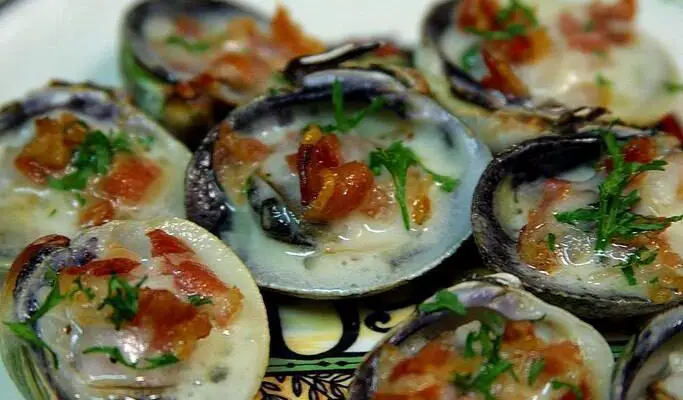The difference between oyster and clam is a fascinating topic, as these two ocean creatures have unique characteristics that set them apart. In this comprehensive blog post, we will delve into the main differences between clams and oysters by exploring their physical traits, habitats, ecological roles, nutritional value, culinary uses, harvesting techniques and threats to their populations.
As you read on, you’ll discover how shell shape variations affect both clams and oysters while learning about the impact of ocean acidification on their shell formation. We will also examine the essential roles they play in maintaining marine habitats and saltwater environments.
Moreover, we will compare the nutritional benefits of consuming clams versus oysters by discussing vitamins and minerals found in each species. You can expect an informative discussion about various clam varieties as well as diverse species offered by pearl oysters such as Olympia Oyster or Pacific Oyster.
Lastly but not least important: consumption methods & wine pairings for both bivalve mollusks are covered so that you can enjoy these delicacies at their finest. Furthermore; insights into harvesting techniques along with potential threats to clam and oyster populations due to human activities provide a broader understanding of these intriguing organisms.
In summary: our extensive analysis regarding the difference between oyster and clam aims to enlighten readers with valuable knowledge about these captivating marine dwellers while offering practical advice for enjoying them responsibly.
Table of Contents:
- Physical Differences Between Clams and Oysters
- Habitats and Ecological Roles of Clams and Oysters
- Nutritional Value of Clams vs. Oysters
- Different Types of Clam Varieties & Culinary Uses
- Diverse Species & Flavors Offered By Oyster Selections
- Clams and Oysters: How to Enjoy Them with Wine
- Harvesting Techniques & Threats To Clam And Oyster Populations
- FAQs in Relation to Difference Between Oyster and Clam
- Conclusion
Physical Differences Between Clams and Oysters
Clams and oysters may look similar, but their shells tell a different story. Clams have stout, oval-shaped shells, while oysters have more irregularly shaped shells, often with one side being flatter than the other.
Shell Shape Variations
- Clam shells: symmetrical, oval or elongated in shape, can be smooth or ridged.
- Oyster shells: asymmetrical, irregular shapes ranging from round to oblong; usually rougher in texture compared to clam shells.
The reason for these different shell structures lies in how each species builds its own protective covering. Both clams and oysters create their shells using calcium carbonate secreted by specialized cells within their soft tissues. However, they deposit this material differently – clams produce two equal-sized valves that fit together perfectly while oyster valves vary significantly in size and shape.
The Impact of Ocean Acidification on Shell Formation
Ocean acidification poses a significant threat to both clam and oyster populations as it affects their ability to construct these protective coverings. As seawater becomes more acidic due to increased carbon dioxide levels from human activities like burning fossil fuels, calcium carbonate becomes less available for marine organisms. Calcium carbonate scarcity due to human-induced ocean acidification hinders the ability of clams and oysters to form or preserve their shells, increasing their susceptibility to predation and other environmental risks.
Protecting our oceans and the creatures that inhabit them is essential. Check out Ocean Conservancy for ways to get involved.
Habitats and Ecological Roles of Clams and Oysters
Clam populations are the unsung heroes of coastal areas, preventing erosion and stabilizing sediments in saltwater environments like estuaries, beaches, and tidal flats. These bivalve mollusks filter water, recycle nutrients, and keep the ecosystem in check.
Clams: The Coastal Area Maintenance Crew
- Filtering water: Clams are like the Brita filters of the ocean, removing particles and improving water quality.
- Erosion control: Their burrowing behavior stabilizes sediment layers along shorelines, reducing erosion rates.
- Nutrient cycling: Clams recycle nutrients back into aquatic ecosystems, keeping the food chain going.
Oyster reefs, on the other hand, are like bustling cities for marine creatures. These complex structures provide shelter and food sources for a diverse range of ocean dwellers.
Oyster Reefs: The Biodiversity Hotspots
- Biodiversity hotspots: Oyster reefs are like the Times Square of the ocean, attracting a wide range of species due to their three-dimensional structure.
- Water filtration: Like clams, oysters filter large volumes of water, removing pollutants and improving overall clarity levels.
- Coastal protection: Oyster reefs can help buffer against storm surges and wave energy, reducing the impacts of coastal erosion.
Clams and oysters are vital to their environments, thus it is essential to safeguard them from dangers such as overfishing and contamination. So let’s give these ocean creatures the appreciation they deserve.
Nutritional Value of Clams vs. Oysters
Clams and oysters offer a nutritious boost to your diet, but it is important to practice moderation when consuming seafood due to the risk of mineral toxicity. However, be careful not to overindulge as excessive seafood consumption can lead to mineral toxicity.
Clams: A Nutrient Powerhouse
Clams are packed with vitamin B12, which is essential for healthy nerve cells and red blood cell production. Clams are an excellent source of vitamins A, B12, iron, selenium, manganese, phosphorus, potassium, zinc and copper – all essential for good health. These nutrients help boost your immune system and energy levels.
Oysters: A Zinc-Rich Delight
Oysters are a great source of zinc, which supports your immune system and taste buds. They also contain omega-3 fatty acids for heart health, vitamin D for strong bones, magnesium for muscle function, and iodine for thyroid regulation.
- Pro Tip: Raw or undercooked shellfish can cause foodborne illness, so be cautious when consuming them.
- If you have seafood allergies or dietary restrictions, consult your healthcare provider before adding clams or oysters to your diet.
To enjoy the benefits of these nutritious bivalves, try incorporating them into your meals in moderation. For example, add clams to spaghetti alle vongole or enjoy oysters on the half shell with lemon wedges and horseradish sauce.
Different Types of Clam Varieties & Culinary Uses
Clams are the ultimate seafood chameleons, with a variety of types available depending on location. These bivalves offer unique flavors and textures that can be used in various dishes to create mouthwatering culinary experiences.
Littleneck Clams: Small but Mighty
Littleneck clams are the smallest variety, making them perfect for delicate dishes like Spaghetti alle Vongole or Spanish seafood paella. Their tender meat is easily absorbed by pasta sauces, creating a harmonious blend of flavors. Additionally, their small size makes them ideal for serving raw on the half shell as an appetizer or added to salads for extra protein and flavor.
Topneck Clams: Big Flavor, Big Possibilities
Topneck clams are larger than littlenecks but still offer tender meat suitable for many recipes. One popular dish featuring topnecks is stuffed quahog, where the clam’s large shells provide ample space to hold a savory breadcrumb mixture combined with chopped clams before being baked until golden brown. Grilling or steaming topnecks is a great option for summer cookouts.
Cherrystone and Quahog Clams: More to Explore
Beyond these two common varieties, there are other types of clams worth exploring in your culinary adventures such as cherrystone (medium-sized) and quahog (large). Each offers its own unique taste profile suited to specific cooking techniques and dishes.
Remember to always consider sustainable harvesting practices when purchasing seafood products like clams. Seafood Watch is a great resource for this. By doing so, you can enjoy these delectable bivalves while also supporting healthy marine ecosystems.
Diverse Species & Flavors Offered By Oyster Selections
Oysters are fascinating ocean creatures that come in a variety of species, each offering unique flavors and textures. Some of the most popular oyster varieties include Olympia (most common), Kumamoto, which take around three years to grow, and Sydney Rock oysters that can live for up to 10 years.
Olympia Oyster Characteristics
The Olympia oyster, native to the Pacific Northwest and prized for its small size, sweet flavor, and delicate texture, has been savored by people for centuries. These bivalve mollusks have been enjoyed by people for centuries due to their delicious taste and nutritional benefits.
Comparing Pacific and Atlantic Oyster Flavor Profiles
Pacific oysters: Known for their sweeter taste profile compared to other types of pearl oysters, these saltwater dwellers also boast plumper meat with a slightly creamy consistency. The rich flavors make them an excellent choice when dining on raw or cooked preparations alike.
Atlantic oysters: With more salty, briny flavors than their Pacific counterparts, Atlantic varieties offer chewier meat textures that many seafood enthusiasts appreciate. Their distinct taste makes them ideal candidates for dishes like oyster stew.
- Note: It’s essential always to source your shellfish from reputable suppliers who follow sustainable practices as overfishing poses significant threats not only to oyster populations but also to marine habitats and ecosystems. Learn more about sustainable seafood choices.
Whether you’re an experienced oyster connoisseur or a curious newcomer, there’s no denying the allure of these unique ocean creatures. From Olympia to Kumamoto, Sydney Rock, Pacific, and Atlantic varieties – each offers something different for your palate. So, eat oysters and enjoy the taste of the ocean.
Clams and Oysters: How to Enjoy Them with Wine
Clams and oysters are versatile seafood options that can be enjoyed in various ways. From raw to cooked preparations, these shellfish offer unique flavors and textures that pair well with different wines.
Pairing Wine with Popular Clam Dishes
Clam linguine is a classic Italian dish where clams are steamed in white wine, garlic, and olive oil. A crisp Pinot Grigio or Sauvignon Blanc is an ideal accompaniment to the classic Italian clam linguine dish. New England clam chowder pairs nicely with an unoaked Chardonnay due to its creamy texture.
Wine Pairings for Different Types of Oysters
Oyster lovers often enjoy them raw on the half-shell accompanied by lemon wedges and horseradish sauce. When it comes to pairing wines with raw oysters, consider opting for a mineral-driven Muscadet or Champagne as they complement the briny taste of fresh oysters beautifully. Baked oyster recipes like Oysters Rockefeller call for richer whites such as Chardonnay or Viognier due to their buttery sauces.
Wine Pairings for Specific Oyster Varieties
- Olympia Oyster: These small but flavorful bivalves go well with sparkling wines like Cava or Prosecco.
- Kumamoto Oyster: Known for their sweet and creamy taste, Kumamotos pair nicely with a crisp Sauvignon Blanc or Albarino.
- Sydney Rock Oyster: These Australian natives have a rich, savory flavor that works well with a zesty Riesling or Gruner Veltliner.
Clams and oysters can be enjoyed in various cooking methods. Clams are often served steamed or cooked within dishes like paella, while oysters can be consumed raw, baked, grilled, or even fried. No matter how you choose to enjoy these delicious shellfish options, there’s sure to be a perfect wine pairing waiting for you.
Harvesting Techniques & Threats To Clam And Oyster Populations
Human activity, such as overfishing, habitat destruction and pollution, poses a significant threat to clam and oyster populations which can disrupt the balance of oceanic systems. These factors negatively impact natural ecosystems that support these creatures’ ability to coexist alongside numerous marine organisms relying on interconnected food chains maintaining balance in oceanic systems globally. Let’s dive into the methods used in clam harvesting and the impact of human activities on both clam and oyster populations.
Methods used in clam harvesting
Clam harvest techniques vary depending on the species and location. Some common methods include hand digging, using rakes or shovels, or employing hydraulic dredges for larger-scale operations. While some of these techniques can be sustainable when managed properly, they can also lead to habitat destruction if not regulated carefully.
Impact of human activities on clam and oyster populations
- Overfishing: Excessive fishing pressures have led to declining numbers of clams and oysters worldwide. This has resulted in stricter regulations being put into place by governments around the world with an aim towards more sustainable practices.
- Habitat Destruction: Coastal development projects often disrupt vital habitats such as seagrass beds where many bivalves reside. Additionally, destructive fishing practices like bottom trawling cause damage that takes years for ecosystems to recover from fully.
- Pollution: Chemical contaminants found within water sources pose threats not only directly but indirectly through bioaccumulation processes occurring along food chain pathways leading ultimately back onto our plates during consumption events involving seafood products. Sources and Solutions for Oyster and Clam Populations
- Climate Change: Rising ocean temperatures and acidification due to increased carbon dioxide levels in the atmosphere can negatively impact shell formation, reproduction rates, and overall survival chances for both clams and oysters. This is particularly concerning given their importance within marine ecosystems as filter feeders helping maintain water quality standards essential for supporting diverse aquatic life forms present throughout our oceans globally. Climate Change and Bivalve Mollusk Fisheries
To protect these valuable species, we must develop sustainable harvesting methods, invest in habitat restoration projects, reduce pollution sources entering our waterways, and address broader climate change concerns impacting global environments. It requires collective efforts from all sectors of society working together towards shared goals preserving Earth’s natural resources for future generations.
Key Takeaway:
Human activity poses a significant threat to clam and oyster populations due to overfishing, habitat destruction, and pollution. Clam harvest techniques vary depending on the species and location. To protect these valuable species, we must develop sustainable harvesting methods, invest in habitat restoration projects, reduce pollution sources entering our waterways, and address broader climate change concerns impacting global environments.
FAQs in Relation to Difference Between Oyster and Clam
Clams vs. Oysters: What’s the Difference?
Which is Healthier: Clams or Oysters?
Oysters are the clear winner when it comes to health benefits, packing more vitamins and nutrients than clams.
Similarities Between Clams and Oysters
- Both are bivalve mollusks with hinged shells.
- Both filter-feeders that consume plankton from surrounding water.
- Both are popular seafood choices worldwide.
- Both are susceptible to environmental threats like pollution and overfishing.
- Both are cultivated through aquaculture practices for sustainable production.
Fun Facts About Clams and Oysters
- Some species of clams can live up to 500 years old.
- Oyster reefs provide critical habitat for various marine organisms.
- Giant clams obtain nutrition via symbiotic algae living within their tissues.
- Oysters can filter up to 50 gallons of water per day, improving water quality in their environment.
Conclusion
Clams vs Oysters:
Discover the physical differences, habitats, nutritional value, and culinary uses of clams and oysters, as well as the diverse species and flavors offered by oyster selections.
Explore consumption methods and wine pairings for these delicious seafood options, and learn about harvesting techniques and threats to clam and oyster populations.
Knowing the distinctions between oysters and clams is advantageous for those who savor seafood or are simply curious about these sea creatures.



